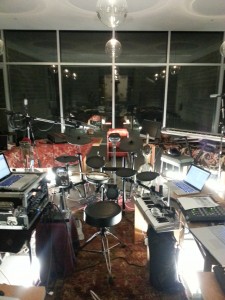Being able to focus full time on the creative process and having full access to the appropriate resources and space is the peak experience for me. Plus working with a team that is able to function artistically as well as domestically is crucial. Not only is the Center fully stocked with any kind of technical gear that may be needed but also the watermill library and archives house approximately 16,000 titles. Highlights include artists’ monographs, seminal works on tribal art, and publications by and about Robert Wilson. Books, photographs, films, and other documents from the Robert Wilson archive offer a chance to explore the life and work of Bob and his collaborators. Living quarters are clean and spacious with beautiful views of the six acres of artist-designed and landscaped grounds. There’s a massive gourmet style Kitchen fully stocked with every and anything you would need and a huge naturally lit dining room, which by the way we’ve decided too take over and transform into our performance space. I can go from programing the show in the dining room, move to the kitchen to discuss the order of scenes and then to the adjourning gallery to shoot video, all within a few feet of each other. We can work anytime of day or night at FULL VOLUME!!!!!
‘the watermill center is the realization of an artistic spirit and vision long shared by robert wilson and his collaborators. in the 1960s, wilson founded the byrd hoffman school of byrds in his loft at 147 spring street in new york city’s soho neighborhood as an entity to produce his early theatrical work. together with the byrds, wilson created legendary performance pieces such as deafman glance, the life and times of joseph stalin, a letter for queen victoria, and einstein on the beach.
in 1992, wilson founded the watermill center on the long island site of a former western union communication research facility as a continuation of his earlier downtown living, research, and rehearsal space that brought together artists and scholars from all disciplines to collaborate on new artistic and theatrical forms. for decades, the east end has been home to some of the most important american artists such as willem de kooning, jackson pollock, lee krasner, jerome robbins, edward albee, cindy sherman, eric fischl, george condo, mary heilmann and roy lichtenstein. wilson was drawn to the site of watermill both as a hub of scientific and artistic exploration and because of the natural beauty of the surrounding area. the center is located in water mill, new york, on the eastern end of long island, approximately a two-hour drive from new york city’
